335. Once again. The Chinese list is beginning at the tip of the tail of the Blue Dragon, beyond the Raven constellation and the tail of the Red Bird:
... The Blue Dragon began already at Spica and Heze (*205, October 12, 285 = 365 - 80):

| The Blue Dragon: |
| 1 |
Horn |
α Virginis (Spica) |
Crocodile |
(202.7) |
Oct 9 (282) |
71.0 |
| 2 |
Neck |
κ Virginis |
Dragon |
(214.8) |
Oct 21 (294) |
| 3 |
Root |
α Librae (Zuben Elgenubi) |
Badger |
(224.2) |
Oct 31 (304) |
| 4 |
Room |
π Scorpii (Vrischika) |
Hare |
(241.3) |
Nov 17 (321) |
| 5 |
Heart |
σ Scorpii |
Fox |
(247.0) |
Nov 23 (327) |
| 6 |
Tail |
μ Scorpii (Denebakrab) |
Tiger |
(254.7) |
Nov 30 (334) |
| 7 |
Winnowing Basket |
γ Sagittarii (Nash) |
Leopard |
(273.7) |
Dec 19 (353) |
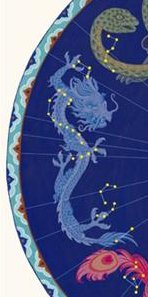 |
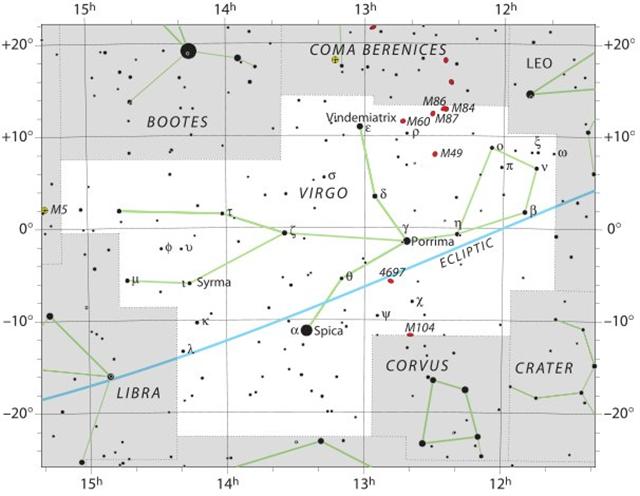
... When a fire is quickly quenched a lot of smoke emerges, therefore smoking is a sign of darkness and of water (there are 10 clouds heavy with raindrops behind the smoking god on the Jaguar throne):
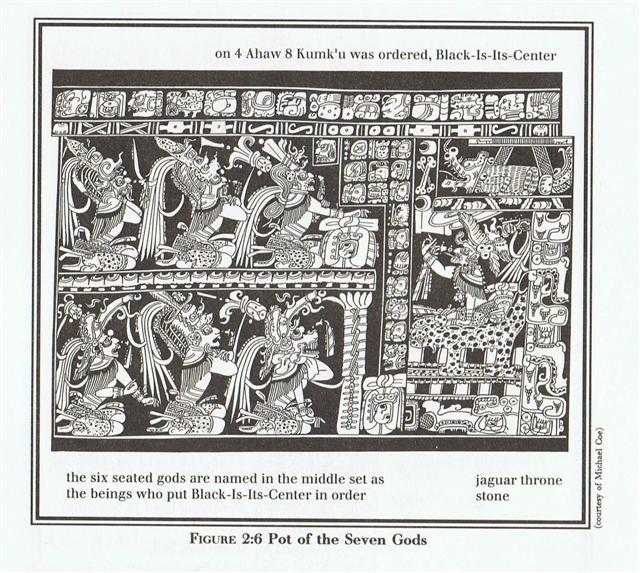
The red fire turns into grey ashes and this happens after the summer heat. There is a crocodile on the roof above the smoking god and we can perceive its meaning, viz. the tail of the Red Summer Bird (at Corvus) was here in the past and the Blue Autumn Dragon had begun (at Spica and Heze) ...
... The aged God L, complete with his cigarette and Muwan Bird headdress, sits inside a house made of mountain-monsters with a crocodile on its roof. Behind him is a bundle called ikatz, 'burden' [amoga], representing the weightiness of his office ...
According to my reconstructions Spica and Algol came after day 378 (counted from Ca1-6):
| Sept 20 (263) |
191 |
March 30 (455) |
31 (90) |
190 |
Oct 8 |
9 (282) |
| no glyph |
 |
 |
 |
 |
| Ca7-24 (192) |
Ca7-25 → 360 |
*Ca14-21 (384) |
*Ca14-22 |
| March 21 (80) |
Sept 29 |
30 (273) |
April 8 |
9 (465) |
| 386 = 2 * 193 |
| no glyph |
 |
4 |
 |
11 + 366 |
 |
 |
| Ca1-1 |
Ca1-6 |
*Ca14-21 (6 + 378) |
*Ca14-22 |
| CLOSE TO THE SUN: |
| SIRRAH |
ALGENIB PEGASI |
4 |
*6 |
11 |
*18 |
*19 |
| March 21 |
22 (81) |
27 (86) |
April 8 (464) |
9 (465) |
| NAKSHATRA DATES: |
| *183 |
*184 (= *1 + *183) |
4 |
*189 |
11 |
*201 |
SPICA & ALCOR |
| Sept 20 |
21 (264 = 81 + 183) |
26 (269) |
Oct 8 (281) |
9 (465 - 183) |
| 386 = 2 * 193 |
And there was a week from the thong of the yoke (the pair of yoga stars) to heliacal Polaris (*26), which came 8 days after day 464:
... Proclus informs us that the fox star nibbles continuously at the thong of the yoke which holds together heaven and earth; German folklore adds that when the fox succeeds, the world will come to its end. This fox star is no other than Alcor, the small star g near zeta Ursae Majoris (in India Arundati, the common wife of the Seven Rishis, alpha-eta Ursae) ...

The creator of the G text placed 71 Virginis immediately before the sign of vacancy (interregnum) - 3 days after *Ca14-21 (*201):
| AUG 7 (219) |
8 (*140) |
 |
 |
| Ga5-29 |
Ga5-30 (140) |
| 71 VIRGINIS (203.6) |
no star listed (204) |
|
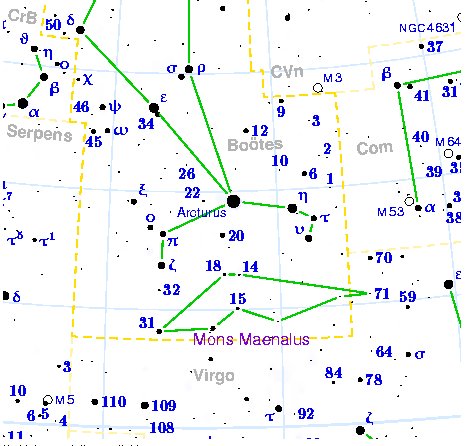
... Mons Maenalus, at the feet of Boötes, was formed by Hevelius, and published in his Firmamentum Sobiescianum; this title coinciding with those of neighboring stellar groups bearing Arcadian names. It is sometimes, although incorrectly, given as Mons Menelaus, - perhaps, as Smyth suggested, after the Alexandrian astronomer referred to by Ptolemy and Plutarch. The Germans know it as the Berg Menalus; and the Italians as Menalo. Landseer has a striking representation of the Husbandsman, as he styles Boötes, with sickle and staff, standing on this constellation figure. A possible explanation of its origin may be found in what Hewitt writes in his Essays on the Ruling Races of Prehistoric Times:
The Sun-god thence climbed up the mother-mountain of the Kushika race as the constellation Hercules, who is depicted in the old traditional pictorial astronomy as climbing painfully up the hill to reach the constellation of the Tortoise, now called Lyra, and thus attain the polar star Vega, which was the polar star from 10000 to 8000 B.C.
May not this modern companion constellation, Mons Maenalus, be from a recollection of this early Hindu conception of our Hercules transferred to the adjacent Bootes? |
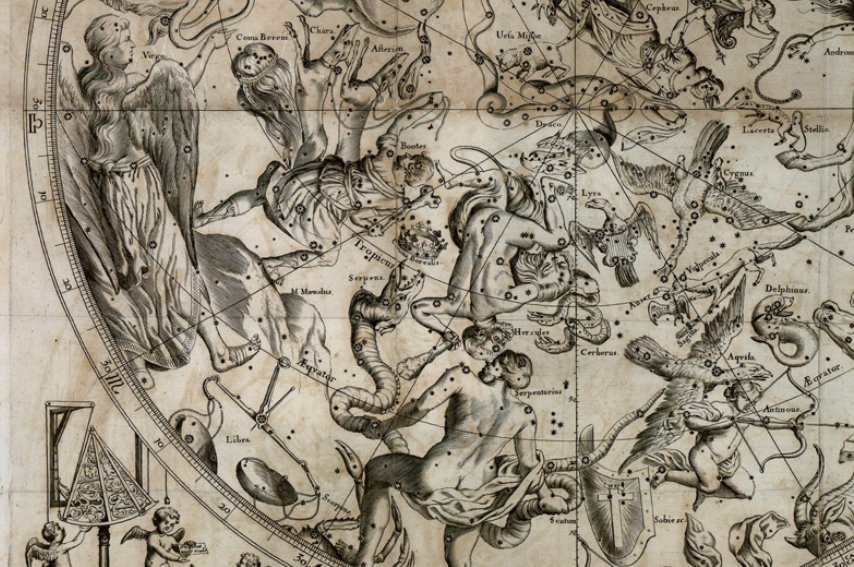
Counted from Ga1-23 this was 117 (= 9 * 13) days later:
 |
116 |
 |
354 |
| Ga1-23 |
Ga5-30 (140) |
| *87 |
*204 |
| 118 = 472 / 4 = 378 - 260 = 398 - 280 |
.. Instead of that old, dark, terrible drama of the king's death, which had formerly been played to the hilt, the audience now watched a solemn symbolic mime, the Sed festival, in which the king renewed his pharaonic warrant without submitting to the personal inconvenience of a literal death.
The rite was celebrated, some authorities believe, according to a cycle of thirty years, regardless of the dating of the reigns; others have it, however, that the only scheduling factor was the king's own desire and command. Either way, the real hero of the great occasion was no longer the timeless Pharaoh (capital P), who puts on pharaohs, like clothes, and puts them off, but the living garment of flesh and bone, this particular pharaoh So-and-so, who, instead of giving himself to the part, now had found a way to keep the part to himself. And this he did simply by stepping the mythological image down one degree. Instead of Pharaoh changing pharaohs, it was the pharaoh who changed costumes.
The season of year for this royal ballet was the same as that proper to a coronation; the first five days of the first month of the 'Season of Coming Forth', when the hillocks and fields, following the inundation of the Nile, were again emerging from the waters. For the seasonal cycle, throughout the ancient world, was the foremost sign of rebirth following death, and in Egypt the chronometer of this cycle was the annual flooding of the Nile. Numerous festival edifices were constructed, incensed, and consecrated; a throne hall wherein the king should sit while approached in obeisance by the gods and their priesthoods (who in a crueler time would have been the registrars of his death); a large court for the presentation of mimes, processions, and other such visual events; and finally a palace-chapel into which the god-king would retire for his changes of costume.
Five days of illumination, called the 'Lighting of the Flame' (which in the earlier reading of this miracle play would have followed the quenching of the fires on the dark night of the moon when the king was ritually slain), preceded the five days of the festival itself; and then the solemn occasion (ad majorem dei gloriam) commenced. The opening rites were under the patronage of Hathor. The king, wearing the belt with her four faces and the tail of her mighty bull, moved in numerious processions, preceded by his four standards, from one temple to the next, presenting favors (not offerings) to the gods.
Whereafter the priesthoods arrived in homage before his throne, bearing the symbols of their gods. More processions followed, during which, the king moved about - as Professor Frankfort states in his account - 'like the shuttle in a great loom' to re-create the fabric of his domain, into which the cosmic powers represented by the gods, no less than the people of the land, were to be woven ...
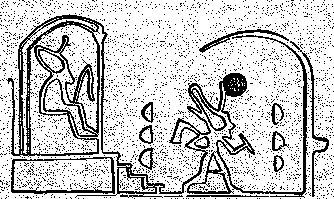
... The king, wearing now a short, stiff archaic mantle, walks in a grave and stately manner to the sanctuary of the wolf-god Upwaut, the 'Opener of the Way', where he anoints the sacred standard and, preceded by this, marches to the palace chapel, into which he disappears. A period of time elapses during which the pharaoh is no longer manifest. When he reappears he is clothed as in the Narmer palette, wearing the kilt with Hathor belt and bull's tail attatched. In his right hand he holds the flail scepter and in his left, instead of the usual crook of the Good Shepherd, an object resembling a small scroll, called the Will, the House Document, or Secret of the Two Partners, which he exhibits in triumph, proclaiming to all in attendance that it was given him by his dead father Osiris, in the presence of the earth-god Geb. 'I have run', he cries, 'holding the Secret of the Two Partners, the Will that my father has given me before Geb. I have passed through the land and touched the four sides of it. I traverse it as I desire.'
| CLOSE TO THE SUN: |
| 9-26 |
9-27 (*190) |
9-28 |
9-29 |
9-30 (273 = 3 * 91) |
| OCT 11 (*204) |
12 |
13 |
14 |
15 (288) |
 |
 |
 |
 |
 |
| Ga8-1 (204) |
Ga8-2 |
Ga8-3 |
Ga8-4 |
Ga8-5 |
| KELB ALRAI (Dog of the Shepherd) = β Ophiuchi, μ Arae (268.1), KEW HO (Nine Rivers) = μ Herculis (268.6), η Pavonis (268.7), APOLLYON = ι Scorpii (268.9) |
MULIPHEN (Oaths) = γ Ophiuchi (269.0), BASANISMUS = G Scorpii (269.5), PHERKARD (Dim One of the Two Calves) = δ Ursae Minoris (269.9) |
PTOLEMY CLUSTER = M7 Scorpii (270.5), GRUMIUM (Lower Jaw) = ξ Draconis (270.9) |
RUKBALGETHI GENUBI (Bending Claw) = θ Herculis (271.1), ξ Herculis (271.5), ETAMIN (Head) = γ Draconis, ν Herculis (271.7), ν Ophiuchi (271.8) |
Cat's Eye = NGC6543 Draconis (272.2), ζ Serpentis (272.4), τ Ophiuchi (272.9) |
| Dec 14 (*268) |
15 |
16 (350) |
17 |
18 |
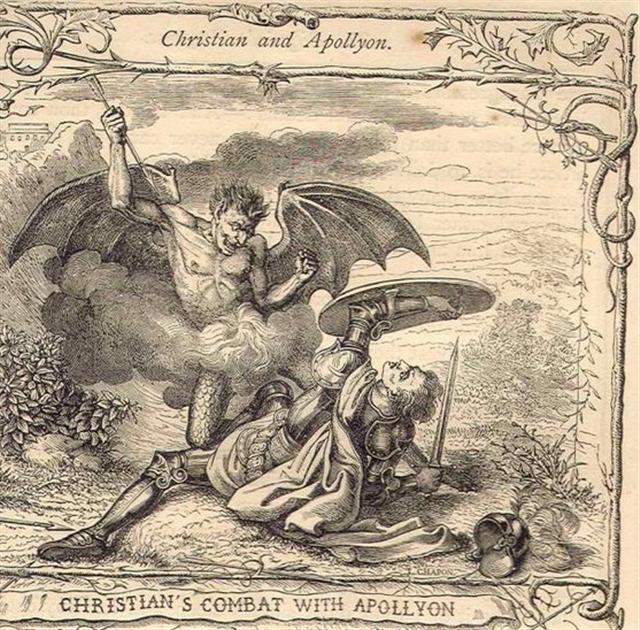 |
| °Dec 10 (*264) |
11 (345) |
12 |
13 |
14 |
| 'Nov 17 (*241) |
18 |
19 |
20 (324) |
21 |
| "Nov 3 (*227) |
4 |
Ko Ruti 5 |
6 (310) |
7 |
| NAKSHATRA DATES: |
| 3-28 |
3-29 |
3-30 |
3-31 (*375) |
4-1 (91) |
| APRIL 12 |
13 (468) |
14 (104) |
15 (*390) |
16 (*26) |
| μ Columbae, SAIPH (Sword) = κ Orionis (86.5), τ Aurigae, ζ Leporis (86.6) |
υ Aurigae (87.1), ν Aurigae (87.2), WEZN (Weight) = β Columbae, δ Leporis (87.7), TZE (Son) = λ Columbae (87.9) |
Ardra-6 (The Moist One) / ANA-VARU-8 (Pillar to sit by)
χ¹ Orionis, ξ Aurigae (88.1), BETELGEUZE (House of the Giant) = α Orionis (88.3), ξ Columbae (88.5), σ Columbae (88.7)
ZUBEN ELGENUBI (α Librae)
|
η Leporis (89.0), PRAJA-PĀTI (Lord of Created Beings) = δ Aurigae, MENKALINAN (Shoulder of the Rein-holder) = β Aurigae, MAHASHIM (Wrist) = θ Aurigae, and γ Columbae (89.3), π Aurigae (89.4), η Columbae (89.7) |
μ Orionis (90.3), χ² Orionis (90.5) |
| June 15 |
16 |
17 (168 = 80 + 88) |
18 |
19 (*90) |

... The earliest depiction that has been linked to the constellation of Orion is a prehistoric (Aurignacian) mammoth ivory carving found in a cave in the Ach valley in Germany in 1979. Archaeologists have estimated it to have been fashioned approximately 32,000 to 38,000 years ago ... The artist cut, smoothed and carved one side (A) and finely notched the other side (B) and the edges. Side A contains the half-relief of an anthropoidal figure, either human or a human-feline hybrid, known as the 'adorant' because its arms are raised as if in an act of worship.
| Egyptian jubilation |
 |
Phoenician he |
 |
Greek epsilon |
Ε (ε) |
|
Wikipedia points at the Egyptian gesture with arms held high as a Sign of jubilation, which may have been the origin (via Phoenician he) of epsilon.


|
On side B together with the four edges is a series of notches that are clearly set in an intentional pattern. The edges contain a total of 39 notches in groups of 6, 13, 7 and 13. A further 49 notches on side B are arranged in four vertical lines of 13, 10, 12 and 13 respectively plus a further notch that could be in either of the middle two lines ... The grouping of the notches on the plate suggests a time-related sequence. The total number of notches (88) not only coincides with the number of days in 3 lunations (88.5) but also approximately with the number of days when the star Betelgeuse (α Ori) disappeared from view each year between its heliacal set (about 14 days before the spring equinox around 33,000 BP) and its heliacal rise (approximately 19 days before the summer solstice).
Conversely, the nine-month period when Orion was visible in the sky approximately matched the duration of human pregnancy, and the timing of the heliacal rise in early summer would have facilitated a ‘rule of thumb’ whereby, by timing conception close to the reappearance of the constellation, it could be ensured that a birth would take place after the severe winter half-year, but leaving enough time for sufficient nutrition of the baby before the beginning of the next winter. There is a resemblance between the anthropoid on side A and the constellation Orion. None of these factors is convincing when taken in isolation, because of the high probability that apparently significant structural and numerical coincidences might have arisen fortuitously. However, taken together they suggest that the anthropoid represented an asterism equivalent to today’s constellation of Orion, and that the ivory plate as a whole related to a system of time reckoning linked to the moon and to human pregnancy. If so, then ethnographic comparisons would suggest that the Geißenklösterle culture related their ‘anthropoid’ asterism to perceived cycles of cosmic power and fertility ...
|
| °June 11 |
12 |
13 (164) |
14 |
15 (*86) |
| 'May 19 (*59) |
20 |
21 (141) |
22 |
23 (*63) |
| "May 5 |
Vaitu Potu 6 |
7 (127) |
8 |
9 (*49) |
 |
 |
 |
 |
 |
| Ga1-22 |
Ga1-23 |
Ga1-24 |
Ga1-25 |
Ga1-26 |
| 10-1 |
10-2 (275) |
10-3 |
| OCT 16 |
17 (290) |
18 (*211) |
 |
 |
 |
| Ga8-6 (209) |
Ga8-7 |
Ga8-8 |
|
Winnowing Basket-7 (Leopard)
18h (273.4)
NASH (Point) = γ Sagittarii (273.7), θ Arae (273.8) |
ZHŌNGSHĀN = ο Herculis (274.0), π Pavonis (274.6) |
ι Pavonis (275.1), POLIS = μ Sagittarii (275.9)
MENKAR (α Ceti)
|
| Dec 19 (*273) |
20 (354) |
SOLSTICE |

... As has already been mentioned, the Delphians worshipped Dionysus once a year as the new-born child, Liknites, 'the Child in the Harvest Basket', which was a shovel-shaped basket of rush and osier used as a harvest basket, a cradle, a manger, and a winnowing-fan for tossing the grain up into the air against the wind, to separate it from the chaff. The worship of the Divine Child was established in Minoan Crete, its most famous early home in Europe. In 1903, on the site of the temple of Dictaean Zeues - the Zeus who was yearly born in Rhea's cave at Dicte near Cnossos, where Pythagoras spent 'thrice nine hallowed days' [27] of his initiation - was found a Greek hymn which seems to preserve the original Minoan formula in which the gypsum-powdered, sword-dancing Curetes, or tutors, saluted the Child at his birthday feast. In it he is hailed as 'the Cronian one' who comes yearly to Dicte mounted on a sow and escorted by a spirit-throng, and begged for peace and plenty as a reward for their joyful leaps ... |
| °Dec 15 (*269) |
16 (350) |
17 |
| 'Nov 22 (*246) |
23 |
24 (328) |
| "Nov 8 (*232) |
9 |
Ko Ruti 10 (314) |
| NAKSHATRA DATES: |
| 4-2 (92) |
4-3 (*378 → Saturn) |
4-4 |
| APRIL 17 (107) |
18 (*393) |
19 (*29) |
| 6h (91.3)
ν Orionis (91.4), θ Columbae (91.5), π Columbae (91.6) |
ξ Orionis (92.5) |
Al Han'ah-4 (Brand) / Maru-sha-pu-u-mash-mashu-7 (Front of the Mouth of the Twins)
TEJAT PRIOR = η Gemini (93.4), γ Monocerotis (93.5), κ Aurigae (93.6), κ Columbae (93.8) |
| June 20 (*91) |
SOLSTICE |
22 (173) |
| °June 16 (*87) |
17 (168) |
18 |
| 'May 24 (*64) |
25 |
26 (146) |
| "May 10 (*50) |
Vaitu Potu 11 |
12 (132) |
 |
 |
 |
| Ga1-27 |
Ga1-28 |
Ga1-29 |
| 10-4 (277) |
10-5 |
10-6 |
| OCT 19 |
20 (293) |
21 (*214) |
 |
 |
 |
| Ga8-9 |
Ga8-10 |
Ga8-11 (214) |
| η Sagittarii (276.9) |
Purva Ashadha-20 (Winnowing Basket) |
| KAUS MEDIUS = δ Sagittarii, κ Lyrae (277.5), TUNG HAE (Heavenly Eastern Sea) = η Serpentis (277.7), SHAOU PIH (Minor Minister) = φ Draconis (277.8), KWEI SHE = χ Draconis (277.9) |
φ Oct. (278.1), KAUS AUSTRALIS = ε Sagittarii (278.3), ξ Pavonis (278.4), AL ATHFAR (The Talons of the Falling Eagle) = μ Lyrae (278.6) |
| Dec 22 |
23 (357) |
CHRISTMAS EVE |
.jpg) |
| °Dec 18 (*272) |
19 |
20 (354) |
| 'Nov 25 (*249) |
26 (330) |
27 |
| "Nov 11 (315) |
Ko Ruti 12 (*235) |
13 |
| NAKSHATRA DATES: |
| 4-5 (95) |
4-6 |
4-7 |
| APRIL 20 (*30) |
21 (111) |
22 (477) |
| FURUD = ζ Canis Majoris (94.9) |
Well-22 (Tapir) / Arkū-sha-pu-u-mash-mashu-8 (Back of the Mouth of the Twins)
δ Columbae (95.2), TEJAT POSTERIOR = μ Gemini, MIRZAM (The Roarer) = β Canis Majoris (95.4), CANOPUS = α Carinae (95.6), ε Monocerotis (95.7), ψ1 Aurigae (95.9) |
no star listed (96) |
| June 23 (*94) |
ST JOHN'S DAY (*460) |
25 (176) |
| °June 19 |
20 (*91) |
SOLSTICE |
| 'May 27 |
28 (*68) |
29 (149) |
| "May 13 (133) |
Vaitu Potu 14 (*54) |
15 (500) |
 |
 |
 |
| Ga1-30 |
Ga2-1 |
Ga2-2 |
.jpg)
 |
| Eb6-1 (185) |
|































.jpg)









.jpg)